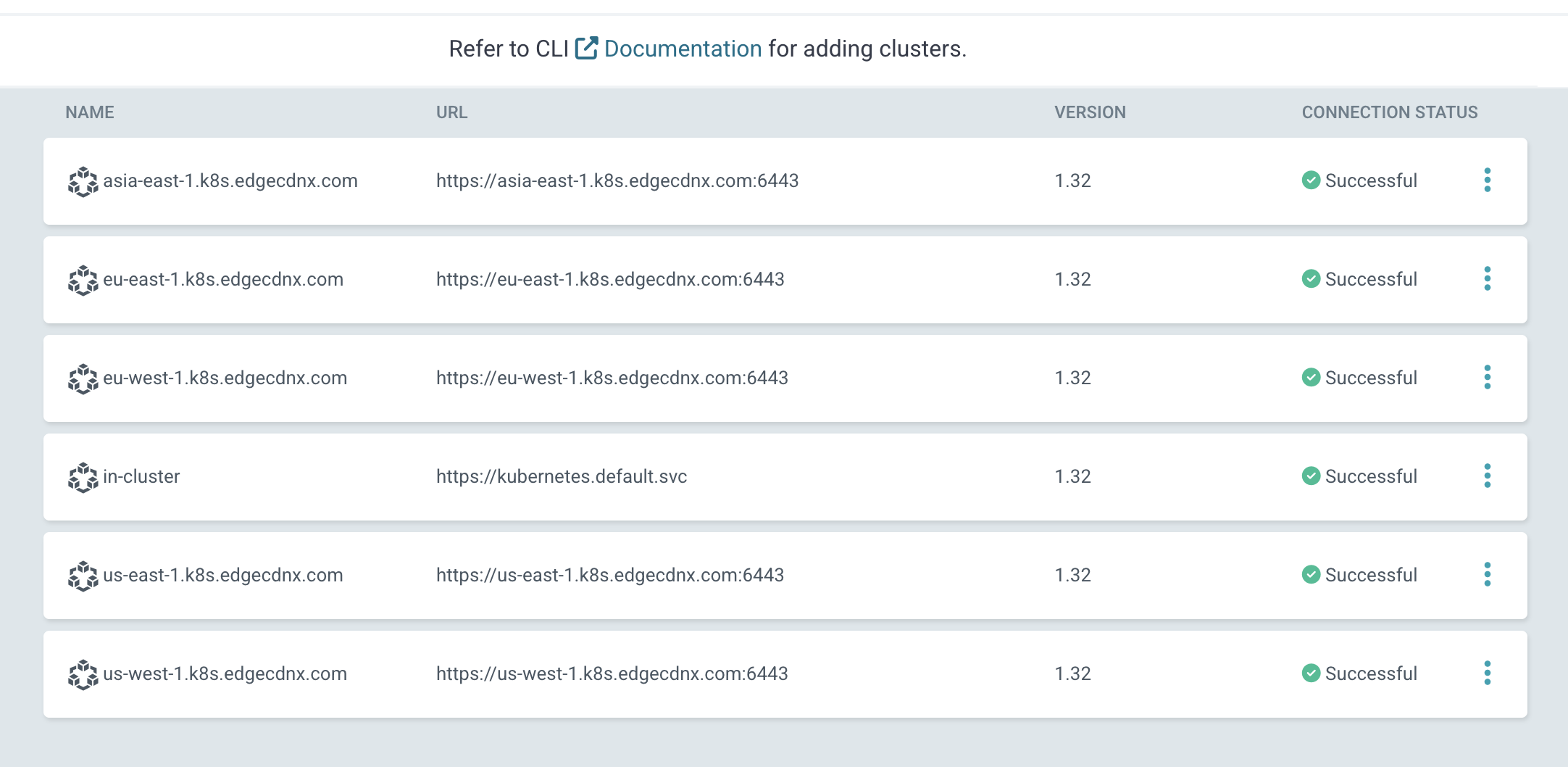Registering Locations
Once we have ArgoCD in place, we can start registering locations to ArgoCD. Please note, that each k8s installation or hosted solutions might be slightly different. In this document we're describing how to register a location for vanilla K8S based installations.
Preparing destination clusters
The destionation cluster must be accessible from the control-plane cluster.
Start by preparing the namespace, service account and token on the destination cluster. you can use the following Ansible Tasks:
- name: Synchronizes ArgoCD variables and cluster definitions
hosts: edgecdnx-cache,edgecdnx-routing,edgecdnx-control
become: true
tasks:
- name: Make sure we have pip installed
package:
name: python3-pip
state: present
- name: Make sure we have kubernetes client installed
pip:
name: kubernetes
state: present
- name: "Create ArgoCD Namespace"
k8s:
state: present
definition:
apiVersion: v1
kind: Namespace
metadata:
name: argocd
- name: "Create Service Account with Admin Rights"
k8s:
state: present
definition:
apiVersion: v1
kind: ServiceAccount
metadata:
name: argocd-manager
namespace: argocd
when: inventory_hostname != 'control.k8s.edgecdnx.com'
- name: "Create Cluster Role Binding for Service Account"
k8s:
state: present
definition:
apiVersion: rbac.authorization.k8s.io/v1
kind: ClusterRoleBinding
metadata:
name: argocd-manager-binding
subjects:
- kind: ServiceAccount
name: argocd-manager
namespace: argocd
roleRef:
kind: ClusterRole
name: cluster-admin
apiGroup: rbac.authorization.k8s.io
when: inventory_hostname != 'control.k8s.edgecdnx.com'
- name: "Create Bearer Token for Service Account"
k8s:
state: present
definition:
apiVersion: v1
kind: Secret
metadata:
name: argocd-manager-token
namespace: argocd
annotations:
kubernetes.io/service-account.name: argocd-manager
type: kubernetes.io/service-account-token
when: inventory_hostname != 'control.k8s.edgecdnx.com'
- name: "Get the CA from the token"
k8s_info:
kind: Secret
namespace: argocd
name: argocd-manager-token
register: token_secret
when: inventory_hostname != 'control.k8s.edgecdnx.com'
- name: "build tlsClientConfig"
set_fact:
clusterConfig:
bearerToken: "{{ token_secret.resources[0].data['token'] | b64decode }}"
tlsClientConfig:
caData: "{{ token_secret.resources[0].data['ca.crt'] }}"
serverName: "{{ inventory_hostname }}"
when: inventory_hostname != 'control.k8s.edgecdnx.com'
These tasks populate the clusterConfig variable for the control plane. Once we have the necessary fields, create secrets with the required metadata.
Routing Cluster
For Routing clusters create a secret with these parameters:
- name: "Register Cluster Config in ArgoCD - Routing"
k8s:
state: present
force: true
definition:
apiVersion: v1
kind: Secret
metadata:
name: cluster-{{ inventory_hostname }}
namespace: argocd
labels:
argocd.argoproj.io/secret-type: cluster
edgecdnx.com/location: "{{ location }}"
edgecdnx.com/routing: "true"
annotations:
edgecdnx.com/public-ip: "{{ public_ip }}"
edgecdnx.com/ns: "{{ ns }}"
edgecdnx.com/namespace: "{{ namespace }}"
edgecdnx.com/basedomain: "{{ basedomain }}"
edgecdnx.com/domainemail: "{{ domainemail }}"
type: Opaque
stringData:
name: "{{ inventory_hostname }}"
server: "https://{{ inventory_hostname }}:6443"
config: "{{ clusterConfig | to_nice_json }}"
delegate_to: control.k8s.edgecdnx.com
when: inventory_hostname in groups['edgecdnx-routing']
- argocd.argoproj.io/secret-type - ArgoCD Specific - required
- edgecdnx.com/location - Defines the location name - e.g. eu-west-1
- edgecdnx.com/routing - (true/false) - set to true if the location is responsible for routing
Annotations
- edgecdnx.com/public-ip - Sets the public IP of the DNS endpoint
- edgecdnx.com/ns - ns id for the location. E.g. for "1" it becomes ns1.
Caching Cluter
For Caching clusters create a secet with these parameters:
- name: "Register Cluster Config in ArgoCD - Caching"
k8s:
state: present
force: true
definition:
apiVersion: v1
kind: Secret
metadata:
name: cluster-{{ inventory_hostname }}
namespace: argocd
labels:
argocd.argoproj.io/secret-type: cluster
edgecdnx.com/location: "{{ location }}"
edgecdnx.com/caching: "true"
edgecdnx.com/tier: "{{ tier }}"
annotations: {}
type: Opaque
stringData:
name: "{{ inventory_hostname }}"
server: "https://{{ inventory_hostname }}:6443"
config: "{{ clusterConfig | to_nice_json }}"
delegate_to: control.k8s.edgecdnx.com
when: inventory_hostname in groups['edgecdnx-cache']
Labels
- argocd.argoproj.io/secret-type - ArgoCD Specific - required
- edgecdnx.com/location - Defines the location name - e.g. eu-west-1
- edgecdnx.com/caching - (true/false) - set to true if the location is responsible for caching
- edgecdnx.com/tier - tier name - currenly unused, reserved for future use
Inventory
Here's an exmaple inventory how this could look for you
edgecdnx-control:
hosts:
control.k8s.edgecdnx.com:
edgecdnx:
children:
edgecdnx-routing:
edgecdnx-cache:
edgecdnx-routing:
hosts:
eu-east-1.k8s.edgecdnx.com:
location: eu-east-1
ns: "1"
public_ip: "11.12.13.14"
namespace: edgecdnx
basedomain: cdn.edgecdnx.com.
domainemail: noc.edgecdnx.com
us-east-1.k8s.edgecdnx.com:
location: us-east-1
ns: "2"
public_ip: "150.151.152.153"
namespace: edgecdnx
basedomain: cdn.edgecdnx.com.
domainemail: noc.edgecdnx.com
edgecdnx-cache:
hosts:
eu-west-1.k8s.edgecdnx.com:
location: eu-west-1
us-west-1.k8s.edgecdnx.com:
location: us-west-1
asia-east-1.k8s.edgecdnx.com:
location: asia-east-1
vars:
tier: edge
Verification
If successfully registered you should see the clusters registered in ArgoCD on your Control Plane

This process is also possible with ArgoCD CLI. Refer to the docs of ArgoCD for registering clusters